Tom explains the songs on the various volumes and what they mean
Volume 1 Inner Galactic Sprint
Beyond Pluto
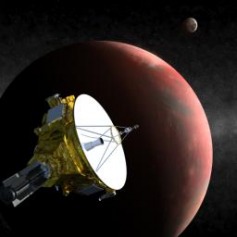
What does lie beyond the Planet or Planetoid Pluto. There are many new discoveries being made which have changed the way we look at the Solar System or perhaps Sol's System as it could be known elsewhere. Then again if there was life on Mars what would they call the Sun? It would take an infinite amount of time for man just to traverse the Solar System as we know it much less a larger version with more Pluto type spheres.
The picture shows the probe New Horizon which will be at Pluto beaming back more data to expand our knowledge base of our neighbors. The picture shows an artist's concept of the spacecraft as it approaches Pluto and its largest moon Charon in July of 2015. It will beam back data about the bodies almost 4.7 billion miles away. Think about that one. For a few ideas about all this go to Bad Astronomy.
Short Cut Warp

The terms time warp, space warp and time-space warp are commonly used in science fiction They sometimes refer to Einstein's theory that time and space forma continuum which bends, folds or warps from the observer's point of view, relative to such factors as movement or gravitation, but are also used in reference to more fantastic notions of discontinuities or other irregularities in spacetime not based on real-world science.
Ring Around the Star
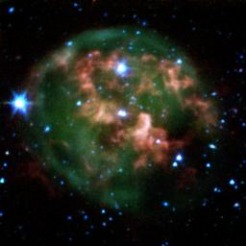
I really didn't know if there was such a phenomenon but it sounded like a great title for a space song. But then NASA gave me the low down. This false-color image from NASA's Spitzer Space Telescope shows a dying star (center) surrounded by a cloud of glowing gas and dust. Thanks to Spitzer's dust-piercing infrared eyes, the new image also highlights a never-before-seen feature -- a giant ring of material (red) slightly offset from the cloud's core. This clumpy ring consists of material that was expelled from the aging star.The star and its cloud halo constitute a "planetary nebula" called NGC 246. When a star like our own Sun begins to run out of fuel, its core shrinks and heats up, boiling off the star's outer layers. Leftover material shoots outward, expanding in shells around the star. This ejected material is then bombarded with ultraviolet light from the central star's fiery surface, producing huge, glowing clouds -- planetary nebulas -- that look like giant jellyfish in space. In this image, the expelled gases appear green, and the ring of expelled material appears red. Astronomers believe the ring is likely made of hydrogen molecules that were ejected from the star in the form of atoms, then cooled to make hydrogen pairs. The new data will help explain how planetary nebulas take shape, and how they nourish future generations of stars.
Comets Go and Come
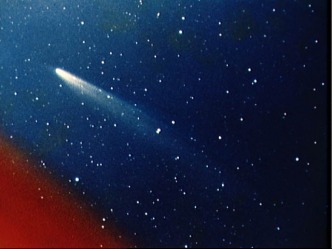
Comets are small, fragile, irregularly shaped bodies composed of a mixture of non-volatile grains and frozen gases. They have highly elliptical orbits that bring them very close to the Sun and swing them deeply into space, often beyond the orbit of Pluto. Comet structures are diverse and very dynamic, but they all develop a surrounding cloud of diffuse material, called a coma, that usually grows in size and brightness as the comet approaches the Sun. Usually a small, bright nucleus (less than 10 km in diameter) is visible in the middle of the coma. The coma and the nucleus together constitute the head of the comet.
The Matter in Darkness

Dark Matter is something that can't be seen, but its presence has been revealed by observations ofthe universe. Billions of years ago, the universe sprang forth with a cataclysmic big bang. As eons of time passes, this early universe slowly cooled and began to evolve. Eventually, stars, galaxies, and the rest of the visible universe took shape. The size of our universe is staggering. Our Sun is large enough to hold one million Earths. The Sun is an average-sized star. Our galaxy contains over 100 billion stars. That's more stars than there grains of sand on the average beach. But there's more. The universe is known to contain billions of galaxies. There is a lot of matter out there. But something seems to be missing. It appears that what we can see may not be all there is. Strong evidence is mounting that suggests there exists large amounts of dark matter in the universe. Scientists estimate that what we do see may only account for 10% of the mass of the universe. That means that 90% of the matter is invisible. Some estimates even place this number as high as 99%. Astronomers refer to this invisible mass as dark matter.
Multiversal Mother Time

The Multiverse theory for the universe has been a recently accepted theory that describes the continuous formation of universes through the collapse of giant stars and the formation of black holes. With each of these black holes there is a new point of singularity and a new possible universe. As Rees describes it, "Our universe may be just one element - one atom, as it were - in an infinite ensemble: a cosmic archipelago. Each universe starts with its own big bang, acquires a distinctive imprint (and its individual physical laws) as it cools, and traces out its own cosmic cycle. The big bang that triggered our entire universe is, in this grander perspective, an infinitesimal part of an elaborate structure that extends far beyond the range of any telescopes." (Rees 3) This puts our place in the Multiverse into a small spectrum. While the size of the earth in relation to the sun is minuscule, the size of the sun, the solar system, the galaxy, and even the universe, could pale in comparison to this proposed Multiverse. It would be a shift in thinking that may help explain our big bang theory and possibly give light to the idea of parallel universes.
Exogenesis Phase 9
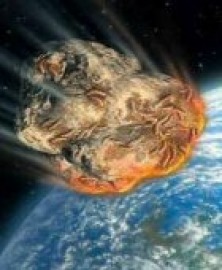
Catherine Conley knows about this subject very well . She's an astrobiologist with NASA's Ames Research Center, and had an experiment onboard Columbia that fateful day. Conley was studying the effects of microgravity on tiny worms called "nematodes."
When Columbia exploded, six canisters of these worms were blasted into the air and fell to Earth. The heat of the blast, the friction of the fall, the impact force of the crash, were all tremendous. Now comes the strange part. Conley was able to retrieve five canisters from the wreckage of Columbia -- and all five still had live nematodes inside!
What does this tell us? No one had intended to do an experiment on whether it is possible for living organisms to survive a fall from space. But fate caused it to happen. And the fact that the nematodes did survive inadvertently gives support to an idea known as "exogenesis."
Exogenesis is the hypothesis that life on Earth may have started somewhere else and then hitched a ride here on an asteroid. The idea is that a big chunk of rock collides with one planet, sending lots of small chunks into space, some of which eventually fall down on another planet. Those chunks might have life inside them, which then gets a start on its new world.
Some scientists had dismissed this notion as impossible because they thought nothing could survive being blasted off one planet and crashing down on another. But Conley's unexpected discovery shows that exogenesis may not be so far-fetched after all.
Fractal Fusion
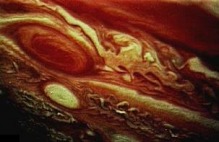
Fractal geometry is a 20th Century discovery of Julia and Mendelbrot and the associative aspects of applying it to the whole universe as a constant is being researched as we speak. To really check out this theory go to http://www.fractaluniverse.org/. I just wanted folks to see the relationship of the mathematical infinity that it provides.
Planet Search in Sector 33
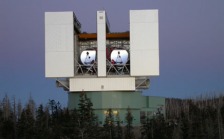
We know they are out there. The billions upon billions of possibilities will yield life and possibly contact with another evolved planet someday. NASA has just launched Kepler with the sole intention of searching for planets that could be like ours or more. http://planetquest.jpl.nasa.gov/
Captured by the Sun
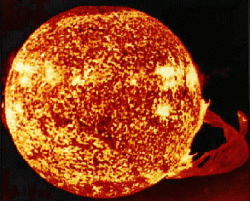
This is a future scifi film...You are on a mission to Mercury in the year 2345 AD and engaging in a maneuver around the tiny planet when you loose a starboard magnetic pulse rectifier. You struggle and struggle to keep the pull of the Sun from grabbing the ship to no avail. You have one last chance but if you don't time it perfectly you will be pulled to the solar inferno. The crew is gathered together and the situation is explained. Everyone must perform a choreographed procedure called a single rectifier double burst. The time comes and....it doesn't work. Your fate is clear. You have been captured by the Sun and there is no escape. It will take 18 days for oblivion to come at exactly 2340 hours on 7 March. Sleeping rigs are set up and last goodbyes are made to Earth and each other. You are not the first to have this happen nor the last. As long as Mercury has the precious radiated solar stone necessary for energy transformers on Earth there will be these dangerous missions. The time grows nearer when our murky brown planet must be left.
Weathered Space Rock
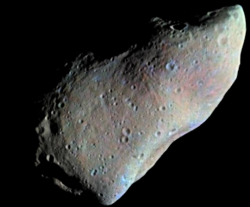
Sure it is out there with our number on it. Waiting to say hello with the bang of a million solar plume bombs. The Earth will not survive this one. Hopefully science and technology can deter its arrival by deflecting the island sized chunk of a planet formerly known as Hazdum to the folks in Cancri who knew all too well what happened that fateful day three million years ago when it got too close to the moon Zebo. But they are giving us our little surprise package with 45 years notice.
Saturnalia

The Roman festival in December dedicated to the god Saturn and the winter solstice. The planet is named after him. This was a time of tom foolery and gift giving as well as other excessive traits. This is perhaps the origin of Christmas though the religious types might disagree. But then it was the Roman Catholic Church wasn't it? I just like the name.
Volume 2 The Ever Expanding Cosmic Void
Stars Always Shine
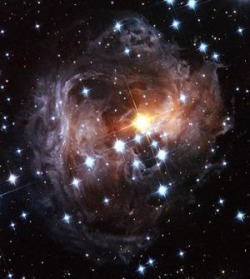
Certainly can be called a universal constant...stars shining. As long as we aren't too far along in the galactic expansion. At some point we might be so far away that there is nothing in the sky to see. So enjoy what we have up there for the next few billion years.
Trippin' in Arp's Galaxy
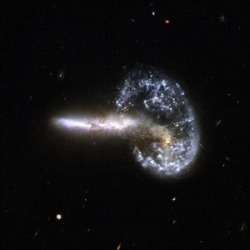
Halton C. Arp is an astrophysicist who's catalogue and observations of irregular shaped galacxes are everyday viewing for many of us. His official web site is here. Quite ironic that a lot of my sounds are generated on an old ARP synth which is of no relation. Rockon Halton. Rockin' Haltin!
Mars' Underworld

If there is such a thing as life on mars I believe that it is well developed underneath the surface where it went when the exterior became barren. We will find out soon what is really the story and then go on to speculate about some other planet.
Meteor Maker
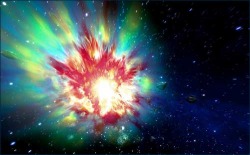
The play on words is one of my favorites. But in reality a crazy explosion or collision of immense heavenly bodies usually can cause those beautiful streaks in the sky at night. I wonder how many of them are the remnants of planets like earth who met their maker.
Pulsaration
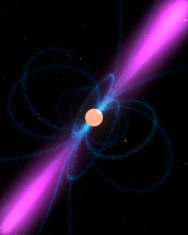
Our interpretation of the physical rhythm and sound generated by a pulsar . We have heard this name for years applied to cars, TVs, radios and many other electronic devices. In reality they are highly energized neutron stars that emit electromagnetic radiation.
Kaguya
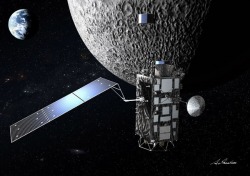
Right on Japan. You have launched KAGUYA which is orbiting the moon sending back every square of surface photographed from a low altitude rendering the most detailed map of the moon we will ever see. Until in the near future we settle Jamestown there that is.
Within the Orb

I just thought that the sounds of this song and the mystique of the orb were cosmic and almost alien.
IC 10
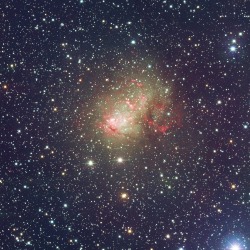
IC 10 is an irregular galaxy in the constellation Cassiopea. It was discovered by Lewis Swift in 1887 but it wasn't until 1935 that Mayall suggested the object was extragalactic. Hubble suspected it belonged to the Local Group of galaxies but then it was found to be receding from the Milky Way strengthening its member ship in the Local Group. It wasn't until 1996 that it was confirmed as a member conclusively. Being obscured by stellar matter it is difficult to observed.
Catch A Galactic Wave

If there will ever be a possibility of surfing a grand wave of energy on some distant planet or in some strange cloud of gas I am sure that there will be a surfer who will find a way to do so. The earth's challenges will be meager by that time and the search for the perfect erupting planet or exploding star will give the space surfer a new reason to have his endless subset turn into the endless universe.
Whoa dude.
Antares Alive
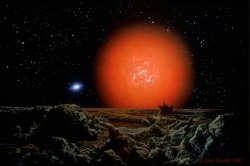
The mystical Antares. The name alone conjures up images of space, science, grandness and bright color. The red supergiant star in the Milky Way is one of the brightest in the sky at night in our present time and space. It is 700 times larger than the Sun. If it were place where the Sun is its outer surface would lie between the orbits of Mars and Jupiter. At 600 light years away the visual luminosity but because of spectrum radiation what they call the bolometric radiation is 65,000 times that of the Sun. The best time to view this old star is around May 31st. It rises at dusk and sets at dawn. Antares has played a major role in the nonscientific world of astrology.
Comet Kahzi
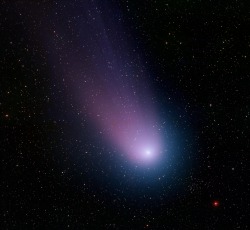
I am sure there is a comet with our number on it blasting through the Universe waiting for the day it kisses the Earth in the noblest of cosmic sacrifices. Perhaps it will destroy us or perhaps it will bring us a new life form to develop here on Earth.
Perjove
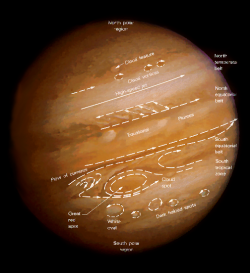
The point of least distance in the elliptical orbit of an object, in this case Jupiter, from its center of attraction, which is generally the center of mass of the system. The farthest point would be called Apojove. Since "peri" and "apo" are Greek, it is considered by some purists more correct to use the Greek form for the body, giving forms such as '-zene' for Jupiter and '-krone' for Saturn. So this song could also be called Perizene. That would sound too much like my medicine I have to take to stop receiving interstellar voices in my brain.
Volume 3 Trans Galaxy Migration
NGC 1300

This Galaxy was discovered in 1887 it is still very popular amongst astronomers. It is a starburst galaxy rich in natural hydrogen gas which is very prevalent. Edwin Hubble also observed this body over the years and found it rather difficult to study because it lies near the plan of the Milky Way ans therefore heavily obscured by interstellar matter*.*Interstellar Matter is a song title on future Volume 5 of Modern Space Music
Olympus Mons

Nearly as large as the state of Arizona and three times the height of Mount Everest, Olympus Mons is the largest volcano--and mountain--in the Solar System. It is thought to be very old, though its last eruption may have been as (geologically) recent as 40 million years ago. It may yet still be active.. Thank you to Felix Fan and his Stradivarius cello for making this piece so haunting and mystical...just like Olympus Mons.Click here for NASA flick.
Exoplanet 221
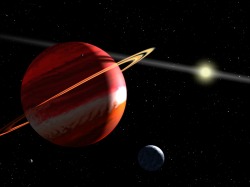
What is an exoplanet? You can find out here. As I grew up I could see Mount Hamilton's Lick Observatory perched on the local peak of the California Coastal Range. They helped discover Exoplanet 221 in the recent past and I thought it would be a tribute to the men and women who are searching the Universe everyday through launched probes as well as the eye and computer to seek out new worlds in systems similar to ours. Exoplanet 221 is the 5th planet in the system it occupies orbiting a sun in the same relationship as Earth to the Sun. I would love to take bets in whether there is life or not. My descendants could collect a lot if we figured in inflation and compounded interest.
Surfing in space would be the ultimate. Everytime I see the fantastic shots of the nebulae clouds it seems like huge waves of energy rolling through the Universe. I am sure that if someone could surf it there will be an attempt. Who says you have to have an ocean when you could have a star system to hang ten through.
Trans Galaxy Migration

Panspermia. Exogenesis. They mean one thing: did life travel through space somehow to reach our planet? Is it possible for beings evolved over a billion years to help us begin? Could it be a normal and natural process that takes place all over the vast Universe? Comets and asteroids could be bringers of life since time began. This could also mean that there is life all over that is developing constantly.
Spaceman

Pictured here is Yuri Gagarin of Russia who was the first spaceman from Earth. On April 12, 1961 he orbited the planet and returned to the planet in one piece which was something for the Cosmonaut program. No one know how many died before attempting a successful orbit and return. In 1972 Harry Nilsson wrote and performed SPACEMAN for the first time. Since then there have been a few covers here and there but we wanted to do something special. We asked our friend Sal Valentino of the Beau Brummels and a great soloist over the years to sing the Pecos Planetary Orchestra's rendition and he did so with an energetic and convincing performance.
The Milky Way Zoo

Why couldn't we one day have a zoo populated by the various animals found on our neighboring exoplanets? Feeding time would take on a new meaning. Of course many of the creatures would be smarter than the handlers. A whole new worry about escapes. We had better hope that the zoo ofthe future has the ultimate safety in mind. If one of these alien animals escapes it might have the effct of a Japanese 50s scifi flick on Earth.
Onward to 55 Cancri E
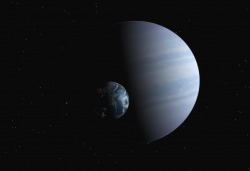
Just like the pioneers of the old American West who made their way across thousands of mile of unknown territories, so will our descendants make their way to the unknown new exoplanets only instead of a conestoga wagon it will be some high power, super stealth ship powered by a yet to be discovered method of unbelievably fast travel. The 60s influence of the spaghetti western complete with twangy guitar rifts and harmonica answering is mixed with the ethereal and haunting echoing melodies of Major Tom's creation. Unnu Larusdottir of Reykjavik provides a vocal respite in the transition singing a simple Icelandic phrase "I 'm coming home" probably like the American pioners felt when the arrived where they knew they would stay.
Check out 55 Cancri E
Muons Detected

Let's be very scientific about this one. Muons are the most numerous energetic charged particles at sea level. A charged particle cannot avoid losing energy by ionization. As it passes through matter the charged particle interacts with the electric fields and typically knocks loose some of the loosely bound outer electrons. A muon interacts very little with matter except by ionization. Because of this, muons can travel large distances and commonly reach the ground. However, they lose energy proportional to the amount of matter they pass. This is proportional to the density (g/cm3) times the path length (cm). This "interaction length" has units of grams per square centimeter.
Martian Life Level 3

They lurk under the surface. They are waiting to meet us. Who? Well certainly not these guys who look like a bad nightmare's imagination. What waits is more embryonic but is is possible that is there has been or is water on Mars and then there could be life but not as we know it. It won't be long until man finds out his closest neighbors are waiting for our help.
Worlds Gone Wild
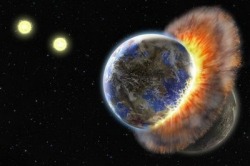
It is like the Ft. Lauderdale of the Universe. A system where planets orbit in a very irregular pattern as to crash into each other every once on a very great while. Like drunk coeds. There are hundreds of them acting like silly people on spring break. Seriously, could you imagine a system with 100 planets and what that would mean?
Alien Upgrade Infusion

They came from exoplanet 334 1 million years ago to help upgrade the fledgling humanoid species on Earth. They took the best of the evolved and gave them genetic infusion to aid them in their long road to thinking and acting rationally. The instinct of survival and family were etched into their DNA which would eventually show promise. It was then that the soul was given to man and that he was declared a citizen of the Universe by those that came before and the his way was possible to go beyond his human existence.
Anchored Above Titan
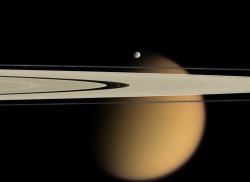
Scenario time. The Saturn Von Braun Mission has been working for 5 years attempting to chart and scout the environs of Titan in hopes of colonization. In their stationary position above the Titan equator much has been gathered from observation as well as landings to support imminent human habitation which is so necessary in the year 2467AD due to the rapidly diminishing atmosphere on the Earth's Moon which was settled by the last 145,000+ Earthlings when all was lost there.
Jupiter System Malfunction SOS
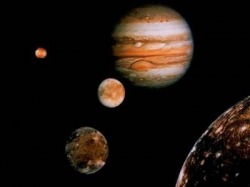
Second scenario time...The Jupiter Manned Mission has been working in and around the Jupiter system for 3 years when suddenly a retro stabilizing rocket conks out and the backup is slow to go on line causing orbital problems for the crew of the station. Until now it has been a wonderfully successful trip with relief on the way due for arrival in 3 weeks. Now the only communication is the old SOS beacon which is the last resort for emergency calls for help. It has been received but no one knows what the problem is and if the Jupiter system crew is surviving. Will they get there in time to help? Will they last until the new crew arrives? Could be a Flash Gordon Saturday afternoon serial......
Volumes 4 & 5 are launched and underway
Major Tom and the Orchestra are in the studio
The working titles are THE COSMOS IS CALLING
and RELIC RADIATION
Check out the song titles
Blueshift
Ice Harvest on Europa
Neutron Collapse
The Cosmos is Calling
Middle Universan
Blinded by the moon
Corot-Exo-7b
Relic Radiation
Comet Lulin Green
Solar Flare Phase Two
Chandrayaan
Starlight Seems Lonely
Welcome to Our World
Interstellar Matter
Europa in Three Parts
A Light Year Away
Fallout from Super Nova 235
Resistance on Planet Thermask
Collision One
Heliopause
Beta Lyrae
Found in Space